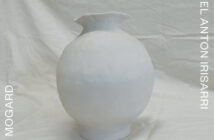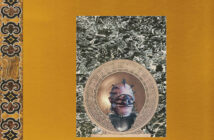
For some people, music is all about the beat, the rhythm, the groove. For some, it’s all about the melody and nuanced phrasing and the hook. For some, it’s all about harmony and the rapture that occurs when voices or instruments seamlessly blend together. For some, it’s all about the pure tones of an instrument or the clarity of a heavenly voice. For some, it’s all about technical skill and virtuoso musicianship. For some, it’s all about raw energy and the wonder of the live moment. For some, it’s all about texture and mood and atmosphere.
This last seems to be the driving philosophy behind David Shea’s Rituals.
Beat, groove, rhythm, melody, harmony, precision skill, raw energy – these are all aspects of the soundscapes and aural-abstracts that he shapes, but they don’t define them. For the most part, they are merely individual textures among the many, components of Shea’s sound-collages. His moods and atmospheres are beautiful and horrifying, melancholy and passionate, languid and energetic, gentle and abrasive. Some songs create many moods, effortlessly or startlingly moving from one to next. Some focus on just a single mood, exploring it to the fullest. Some take us on an almost-literal exploration.
‘Ritual 32’begins by building up a dense blend of droning electronic tones, sub-sonic pulses, synthesiser noodlings, tentative piano strikes, hyper-processed operatic vocals and muffled chanting. This blend is unsettling and somehow sad; it builds in intensity and then slowly fades out, as the piano moves into the foreground. At first, the playing is slightly frenetic, in tandem with the preceding cacophony. All-too-soon, the playing becomes more subdued, conjuring up a mood of resignation and regret. Over time, the spaces between these piano phrases grows longer, only the subtlest of delays battling the emptiness. The mood grows deeper, more regretful, more resigned. Eventually, when it feels like the empty spaces are about to collapse the song in on itself, when we feel like we can’ take any more sadness, the original instrumentation reappears, piece by piece. This time, each piece is introduced gradually and subtly, and the blend slowly moves from an airy underpinning to a subdued and constantly-shifting dominance.
In contrast to this many-mood and multi-themed approach, ‘Emerald Garden’ is much more interested in exploring a single mood and theme, and evokes a much more concentrated atmosphere. It could easily have sported a subtitle, “A Tribute to Horror Filmsâ€, so intense is its atmosphere of fear, anxiety and dread. However, this isn’t where the connections between it and horror films begin and end: “Emerald Green†is a ever-changing, semi-abstract soundscape consisting of innumerable themes, instrumentations and sound-cues inherent to horror movies. Skittering, pizzicato spider-violins; John Carpenter-esque synthesiser pulses; crashes of cymbals; the fluttering of flutes and the deep burr of pounding cellos; mad-scientist pipe organs; thumping kettle-drums; glacial keyboard lines; chirping crickets, hooting owls, howling dogs, and other inhabitants of isolated lands; they are all there, foregrounded or backgrounded, waiting their turn or seizing their moment. The effect of this is incredible, and it provokes an almost physical response.
And these two songs aren’t even the tip of the iceberg. Labels such as good or bad don’t really seem necessary for a work as “different†as Rituals. What it does, it does incredibly well. If there’ space on your metaphorical shelf for anything marked “abstract†or “atmospheric†or “experimentalâ€, it should grab you. If not, you should listen to it anyway. The least it’ll do is take you to a weird and unique place.



